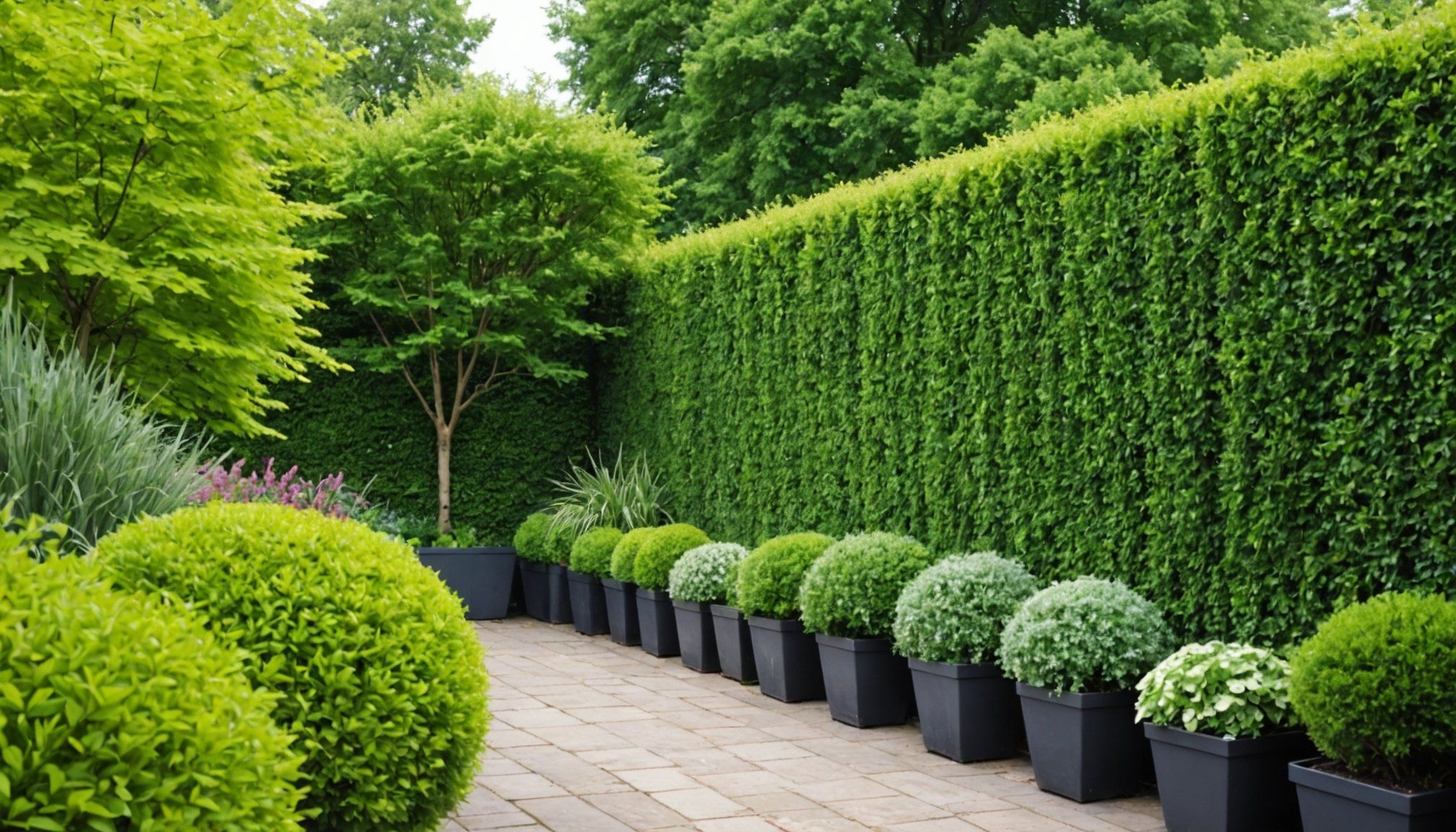Creating an Effective Privacy Screen in Your UK Urban Garden
In the heart of a bustling UK city, your garden can be a serene oasis, but only if you can ensure it remains a private haven. One of the most effective ways to achieve this is by crafting a privacy screen using the right plants. Here’s a comprehensive guide to help you choose and grow the best plants for your garden privacy.
Why You Need a Privacy Screen
Before we dive into the specifics of which plants to use, let’s understand why a privacy screen is essential for your urban garden. In densely populated areas, privacy can be a luxury, especially if you have neighbors living in close proximity. A well-planted privacy screen not only blocks the view from prying eyes but also adds a touch of natural beauty to your garden.
In parallel : Unlock Your Imagination: Innovative Uses of Chalk Paint for Stunning Shabby Chic Decor in the UK
Choosing the Best Plants for Your Privacy Screen
When it comes to selecting plants for your privacy screen, you need to consider several factors such as growth rate, height, spread, and maintenance requirements. Here are some of the best plants that fit the bill:
Evergreen Trees and Hedging Plants
Evergreen trees and hedging plants are ideal for creating a year-round privacy screen. Here are a few top choices:
Also to discover : Top Tips for Creating a Pet-Friendly Home Interior in the UK: Essential Design Considerations
-
Cherry Laurel (Prunus laurocerasus): Known for its fast growth rate and dark green leaves, cherry laurel is a popular choice for hedging. It can grow up to 10 meters tall and is relatively low maintenance.
-
Height Spread: Up to 10 meters tall, 4-6 meters wide
-
Growth Rate: Fast
-
Maintenance: Low
-
Holly (Ilex aquifolium): With its prickly leaves and bright red berries, holly is a great option for a privacy hedge. It is slow-growing but provides excellent year-round screening.
-
Height Spread: Up to 15 meters tall, 5 meters wide
-
Growth Rate: Slow
-
Maintenance: Medium
-
Holm Oak (Quercus ilex): This evergreen tree is known for its dense foliage and can grow quite tall, making it perfect for screening.
-
Height Spread: Up to 20 meters tall, 10 meters wide
-
Growth Rate: Medium
-
Maintenance: Medium
Fast Growing Hedge Plants
If you need a quick solution, here are some fast-growing hedge plants that can provide privacy in no time:
-
Red Robin (Photinia fraseri): With its vibrant red new leaves and fast growth rate, red robin is a favorite among gardeners.
-
Height Spread: Up to 4 meters tall, 2 meters wide
-
Growth Rate: Fast
-
Maintenance: Low
-
Privet (Ligustrum ovalifolium): Privet is another fast-growing option that can be trimmed to maintain a neat shape.
-
Height Spread: Up to 4 meters tall, 2 meters wide
-
Growth Rate: Fast
-
Maintenance: Low
Detailed Comparison of Top Hedge Plants
Here is a comprehensive table comparing some of the top hedge plants for your garden privacy:
| Plant Name | Height Spread | Growth Rate | Maintenance | Special Features |
|---|---|---|---|---|
| Cherry Laurel | Up to 10m tall, 4-6m wide | Fast | Low | Dark green leaves, white flowers in spring |
| Holly | Up to 15m tall, 5m wide | Slow | Medium | Prickly leaves, bright red berries |
| Holm Oak | Up to 20m tall, 10m wide | Medium | Medium | Dense foliage, long lifespan |
| Red Robin | Up to 4m tall, 2m wide | Fast | Low | Vibrant red new leaves |
| Privet | Up to 4m tall, 2m wide | Fast | Low | Easy to trim, dense foliage |
Planting and Maintaining Your Privacy Screen
Planting and maintaining your privacy screen requires some planning and regular care. Here are some tips to get you started:
Planting
- Choose the Right Location: Ensure the area where you plan to plant your hedge or trees receives the right amount of sunlight and has well-draining soil.
- Plant at the Right Time: Spring and autumn are the best times to plant evergreen trees and hedging plants in the UK.
- Space Correctly: Plant your hedge plants or trees at the recommended spacing to ensure they grow evenly and provide effective screening.
Maintenance
- Regular Pruning: Prune your hedge plants regularly to maintain shape and promote healthy growth.
- Watering: Ensure your plants receive adequate water, especially during their first year of growth.
- Fertilization: Fertilize your plants annually to promote healthy growth and dense foliage.
Additional Tips for a Beautiful and Private Garden
Here are some additional tips to enhance your garden’s privacy and beauty:
Incorporate Flowers and Shrubs
Adding flowers and shrubs around your privacy screen can enhance its aesthetic appeal. For example:
- White Flowers: Plants like cherry laurel and privet produce white flowers in the spring, adding a touch of beauty to your garden.
- Red Berries: Holly and other berry-producing plants can add a pop of color during the winter months.
Use a Mix of Plants
Using a mix of evergreen trees, hedging plants, and flowering shrubs can create a diverse and vibrant garden.
Consider Vertical Gardening
If space is limited, consider using vertical gardening techniques to create a living wall that also serves as a privacy screen.
Practical Insights and Actionable Advice
Here are some practical insights and actionable advice from gardening experts:
-
“The key to a successful privacy screen is to choose plants that are suitable for your climate and soil type. Also, regular pruning is essential to maintain shape and promote healthy growth.” – Jane Smith, Gardening Expert
-
“Mixing different types of plants can add variety and interest to your garden. For example, combining evergreen trees with flowering shrubs can create a beautiful and private garden.” – John Doe, Landscape Designer
Creating an effective privacy screen in your UK urban garden is not just about blocking the view; it’s about enhancing the beauty and tranquility of your outdoor space. By choosing the right plants, such as cherry laurel, holly, and red robin, and following the tips outlined above, you can enjoy a private and serene garden oasis in the heart of the city.
Remember, the right combination of evergreen trees, hedging plants, and flowering shrubs can make your garden not only private but also a stunning haven that you’ll love spending time in. Happy gardening
Introduction to Urban Privacy Screens
Living in a bustling city, maintaining privacy in an outdoor space can be challenging. As urbanization rises, the need for seclusion in our gardens becomes essential. An effective solution is implementing privacy screens. These structures not only shield from prying eyes but also add an aesthetic charm to your garden.
Importance of Privacy in Urban Gardens
With apartments and homes closely packed, privacy becomes a luxury. The right privacy screens can transform an exposed urban garden into a sanctuary. They allow for personal space and solitude amidst the urban hustle, elevating the garden’s function from a mere yard to a private retreat.
Overview of Privacy Screens and Their Benefits
Privacy screens come in various forms: fences, hedges, or trellises with climbing plants. Each offers unique advantages, such as noise reduction, shade, and enhancing microclimate. Moreover, they contribute to the urban gardening experience by supporting plant growth and biodiversity.
Introduction to Factors Influencing Plant Selection
Selecting plants for your privacy screens requires thoughtfulness: consider environmental conditions like sunlight, soil type, and local climate. Plant growth rate and maintenance are important as well. Fast-growing climbers like ivy or jasmine can quickly cover a structure, providing effective coverage. Meanwhile, dense shrubs or evergreens offer year-round privacy.
Recommended Plants for Privacy Screens
Choosing the right plants for privacy screens in the UK involves several considerations, including growth speed, evergreen qualities, and aesthetic appeal. Understanding these factors can help create an effective, beautiful barrier.
Fast-Growing Options
For those seeking a quick solution, bamboo varieties are a prime choice. Hardy and fast-growing, many types thrive in the UK’s climate. When selecting bamboo, consider Phyllostachys species, which provide a tall, lush screen. Though rapid, spacing is crucial, as overcrowding can hinder growth. Climbing plants like ivy or honeysuckle also offer swift coverage. They’re ideal for fences or trellises but require support and regular maintenance to manage their expansion.
Evergreen Choices
Conifers such as Leyland cypress are popular for year-round privacy. They grow densely and maintain foliage throughout seasons. Alongside conifers, broadleaf evergreens like holly present a robust option, with the added benefit of vibrant leaves. Keep in mind, maintenance is key—pruning promotes healthy, shaped growth.
Flowering and Foliage Plants
For seasonal charm, deciduous options like Japanese maple provide both privacy and visual interest, transforming with the seasons. Herbaceous perennials, such as hostas, add dynamic beauty while serving functional purposes. By combining such plants, one achieves a privacy solution that is both effective and aesthetically pleasing.
Growth Conditions and Maintenance
Successfully cultivating an urban garden requires understanding and meeting specific growth conditions for your plants. Begin by considering the ideal light requirements. Most plants thrive with a balance of sun and shade. Position them where they receive sufficient sun during peak times, but ensure they have access to shade to prevent scorching.
Soil quality significantly impacts plant care. Urban gardens often utilise pots or raised beds, making soil composition crucial. Choose a fertile, well-draining soil mix to promote healthy root development. Enriching the soil with organic matter can enhance its nutrient profile, supporting plant growth.
Moisture requirements vary. While some plants necessitate consistent watering, others prefer drier conditions. It’s crucial to understand the specific moisture needs of your plants and adjust your watering schedule accordingly. Check soil moisture by feeling the topsoil – if it’s dry, it’s time to water.
Consistency in maintenance ensures plant longevity. Regularly remove dead foliage and prune as needed to encourage new growth. Maintaining cleanliness in the garden prevents disease spread.
Seasonal considerations are vital. As seasons change, adjust practices like watering frequency and plant positioning. Implementing seasonal tasks efficiently aids in sustaining a thriving urban garden year-round.
Design Tips for Privacy Screens
Designing effective privacy screens in your garden requires careful consideration of design principles and how they intertwine with your overall garden layout. Successfully crafting a space that is both private and engaging can greatly enhance your garden’s visual appeal.
Spacing and Arrangement
To create a seamless blend within your garden, meticulous attention should be paid to spacing and arrangement. First, understanding how plants will grow over time is crucial. Consider the eventual height and spread of each plant to ensure sufficient space for growth and density. Planning for this will help maintain an uncluttered appearance while offering the desired privacy.
Layering should be employed to add depth and visual interest. By arranging taller plants at the back and shorter ones up front, you create depth that maximizes the impact of your foliage. Integrating privacy screens with existing garden elements, like paths and patios, can enhance the overall flow and functionality.
Enhancing Visual Appeal
The visual charm of your garden hinges on the strategic use of textures and colors. Mixing plants with different textures, such as combining broad leaves with spiky forms, creates a dynamic and engaging landscape. Additionally, ensuring seasonal interest by selecting plants that offer varying appearances throughout the year keeps the garden lively and ever-changing.
Incorporating architectural features can also add unique focal points, tying together natural and man-made elements for a harmonious design.
Potential Alternatives and Considerations
Exploring alternative solutions for urban gardening can open up a variety of non-plant options that cater to the unique challenges of city living. One such alternative is the use of trellises and panels for maintaining privacy. These structures not only offer privacy but also provide support for climbing plants if space allows. Trellises can be fashioned from a range of materials, ensuring they blend seamlessly with any aesthetic.
When considering alternatives, it’s crucial to keep in mind local regulations and space limitations. Urban settings often have specific guidelines about structures like trellises. Always check with local authorities before installation to avoid unwanted issues.
Environmental factors also play a significant role when selecting plants for urban gardens. Light availability, wind exposure, and even pollution levels can impact plant health. It is wise to choose plants that thrive in limited sunlight or incorporate resilient materials in non-plant solutions to withstand such conditions.
By carefully evaluating these aspects, one can successfully navigate urban gardening challenges. Whether opting for green solutions or exploring non-traditional options, understanding urban gardening limitations ensures your space becomes a thriving and pleasant oasis amidst the city’s hustle. Remember, a well-planned urban garden can enhance your environment considerably.
Conclusion and Further Resources
Exploring garden planning can be both enjoyable and fulfilling. As we’ve navigated through essential topics, it’s crucial to consider further reading that can enhance your understanding and execution of garden projects. These resource links provide additional insights into selecting the right plants and caring for them effectively.
In your journey of cultivating a personalised garden, start by focusing on your unique environmental conditions and personal preferences. This approach ensures that your garden reflects your individual style and meets your specific needs. Many online platforms offer detailed guides on plant varieties best suited for different climates and soil types.
For more comprehensive advice, consider accessing digital libraries and gardening forums. These platforms contain extensive resources for plant care and selection, from perennials to exotic species. They also allow you to connect with a community of enthusiasts and experts, offering diverse viewpoints and practical tips.
Encouraging personalized garden planning not only fosters a deeper connection with nature but also boosts creativity. As you continue to expand your knowledge and skill set, embrace the opportunity to tailor your space into a unique haven. Remember, the art of gardening is an evolving journey that can be enriched with continuous resource exploration and learning.











